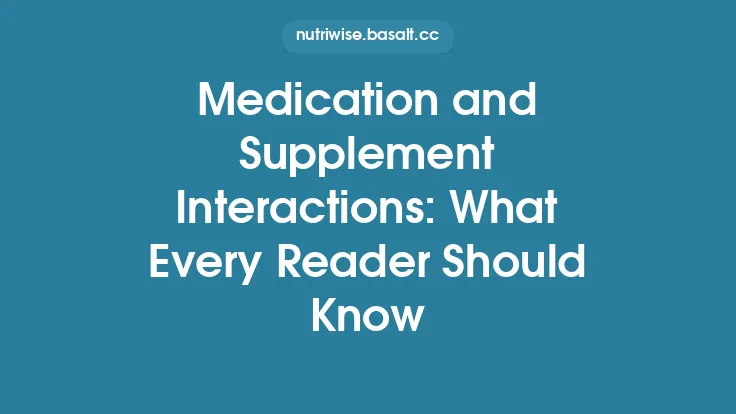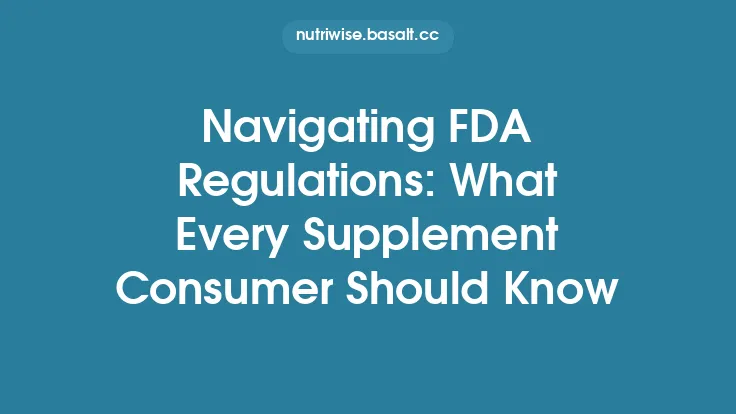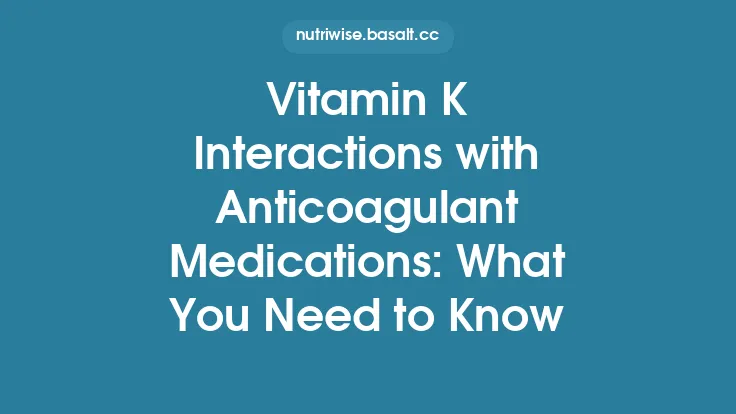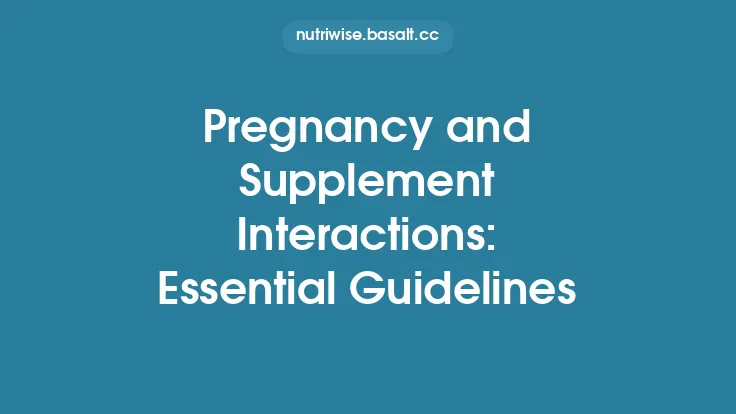Vitamin‑drug interactions are a hidden yet critical component of safe medication use. While many patients focus on prescription instructions, the vitamins they take—whether as part of a multivitamin, a targeted supplement, or a fortified food—can profoundly influence how drugs are absorbed, metabolized, and eliminated. Understanding these dynamics helps patients avoid reduced therapeutic benefit, unexpected side effects, or even serious toxicity. Below is a comprehensive, evergreen guide that walks you through the most common vitamin‑drug pairings, the underlying mechanisms, and practical steps you can take to keep your treatment plan on track.
How Vitamins Influence Drug Absorption
Gastrointestinal pH and Solubility
Many vitamins alter the acidity of the stomach or the composition of intestinal fluids, which can change the solubility of oral medications. For example, high doses of vitamin C (ascorbic acid) lower gastric pH, potentially increasing the dissolution of weakly basic drugs such as certain antihistamines, but decreasing the absorption of drugs that require an alkaline environment (e.g., some antifungal agents).
Binding and Complex Formation
Vitamins can form non‑covalent complexes with drugs, reducing the amount of free drug available for absorption. Vitamin E (α‑tocopherol) is lipophilic and can sequester lipophilic medications within micelles, potentially lowering their bioavailability.
Transporter Competition
Intestinal transport proteins such as the organic anion transporting polypeptides (OATPs) and the peptide transporter 1 (PEPT1) handle both vitamins and drugs. High concentrations of vitamin B6 (pyridoxine) may compete with certain antibiotics that rely on PEPT1, diminishing their uptake.
Metabolic Interactions: The Role of Cytochrome P450 Enzymes
The liver’s cytochrome P450 (CYP) system is the primary hub for drug metabolism. Several vitamins act as either inducers or inhibitors of specific CYP isoforms, thereby altering drug clearance.
| Vitamin | CYP Isoform Affected | Typical Effect | Clinical Implication |
|---|---|---|---|
| Vitamin A (retinol/β‑carotene) | CYP3A4 | Induction (high doses) | May lower plasma levels of statins, certain antihypertensives, and immunosuppressants |
| Vitamin B2 (riboflavin) | CYP1A2 | Inhibition (supplemental doses) | Can increase concentrations of theophylline and certain antipsychotics |
| Vitamin B6 (pyridoxine) | CYP2C9, CYP2C19 | Induction | May reduce efficacy of warfarin analogues (excluding vitamin K pathways) and some oral hypoglycemics |
| Vitamin C | CYP2E1 | Inhibition | Can raise levels of acetaminophen metabolites, raising risk of hepatotoxicity at high doses |
| Vitamin E | CYP3A4 | Inhibition (large doses) | May increase plasma concentrations of calcium channel blockers, certain antivirals, and some chemotherapeutic agents |
*Note:* The magnitude of these effects often depends on the dose and duration of vitamin supplementation. Over‑the‑counter multivitamins typically contain modest amounts that exert minimal impact, whereas therapeutic‑grade preparations can produce clinically relevant changes.
Specific Vitamin‑Drug Pairings to Watch
Vitamin A and Retinoids
- Interaction: High dietary vitamin A or supplemental β‑carotene can potentiate the effects of prescription retinoids (e.g., isotretinoin, acitretin), increasing the risk of teratogenicity and hepatotoxicity.
- Patient Tip: Women of child‑bearing potential should avoid additional vitamin A sources while on retinoid therapy and discuss any supplement use with their prescriber.
B‑Complex Vitamins
Vitamin B1 (Thiamine)
- Interaction: Thiamine supplementation may enhance the efficacy of diuretics that cause thiamine depletion (e.g., loop diuretics), reducing the risk of Wernicke’s encephalopathy in chronic users.
- Patient Tip: If you are on long‑term diuretics, a modest thiamine supplement (e.g., 100 mg daily) can be protective, but always confirm dosing with your clinician.
Vitamin B2 (Riboflavin)
- Interaction: Riboflavin can inhibit CYP1A2, leading to higher plasma levels of certain antipsychotics (e.g., clozapine) and theophylline.
- Patient Tip: Monitor for signs of toxicity (e.g., tremor, insomnia) if you start a high‑dose riboflavin supplement while on these medications.
Vitamin B3 (Niacin)
- Interaction: Niacin at therapeutic doses (≥500 mg) can increase the risk of flushing and hypotension when combined with antihypertensive agents such as alpha‑blockers.
- Patient Tip: Take niacin with food and consider a slow‑release formulation to mitigate flushing; discuss blood pressure monitoring with your provider.
Vitamin B6 (Pyridoxine)
- Interaction: Pyridoxine can reduce the neurotoxic side effects of isoniazid (an anti‑tuberculosis drug) but may also diminish the anticoagulant effect of certain oral anticoagulants that are metabolized by CYP2C9.
- Patient Tip: If you are on isoniazid, a prophylactic pyridoxine dose (25–50 mg daily) is often recommended. For anticoagulant therapy, inform your clinician before adding high‑dose B6.
Vitamin B9 (Folate) and B12
- Interaction: Folate supplementation can mask hematologic toxicity of methotrexate, a disease‑modifying antirheumatic drug, while high‑dose B12 may interfere with the metabolism of certain chemotherapeutic agents (e.g., methotrexate analogues).
- Patient Tip: Patients on methotrexate should have regular complete blood counts and discuss any folate supplementation with their rheumatologist.
Vitamin C (Ascorbic Acid)
- Interaction with Anticoagulants: While vitamin K is the classic antagonist, high‑dose vitamin C can also affect platelet function, modestly enhancing the effect of antiplatelet drugs (e.g., aspirin, clopidogrel) and increasing bleeding risk.
- Interaction with Chemotherapy: Vitamin C at pharmacologic concentrations (IV administration) may act as a pro‑oxidant, potentially augmenting the cytotoxicity of certain chemotherapeutic agents (e.g., alkylating agents). Conversely, oral vitamin C may protect normal cells, possibly reducing drug efficacy.
- Interaction with Antihistamines: Acidic gastric environment from vitamin C can improve the absorption of some H1‑antagonists, leading to higher plasma levels.
- Patient Tip: Keep vitamin C supplementation below 1 g per day unless under medical supervision, especially if you are on anticoagulants or chemotherapy.
Vitamin E (Tocopherols)
- Interaction with Antiplatelet/Anticoagulant Therapy: Vitamin E possesses mild antiplatelet activity. When combined with aspirin, clopidogrel, or warfarin analogues, it can increase bleeding time.
- Interaction with Statins: High‑dose vitamin E may inhibit CYP3A4, raising statin concentrations and the risk of myopathy.
- Interaction with Hormone Therapy: Vitamin E can alter the metabolism of estrogen‑containing oral contraceptives, potentially reducing contraceptive efficacy.
- Patient Tip: If you are on any antithrombotic regimen, limit vitamin E intake to ≤400 IU/day and discuss any changes with your healthcare provider.
Vitamin B12 (Cobalamin)
- Interaction with Metformin: Metformin can impair B12 absorption, leading to deficiency. Conversely, B12 supplementation does not interfere with metformin’s glucose‑lowering effect but can improve neuropathic symptoms.
- Interaction with Proton‑Pump Inhibitors (PPIs): PPIs reduce gastric acidity, hindering B12 release from food; supplementation may be necessary, but high doses do not affect PPI efficacy.
- Patient Tip: Periodic B12 level checks are advisable for patients on long‑term metformin or PPIs, especially if neuropathy develops.
Practical Strategies for Patients
- Create a Complete Medication List
Include every prescription, over‑the‑counter drug, vitamin, mineral, herb, and fortified food. Bring this list to every medical appointment.
- Timing Matters
- Separate Administration: For vitamins that affect gastric pH (e.g., vitamin C) or bind drugs (e.g., vitamin E), take them at least 2 hours apart from the medication.
- With Food vs. Empty Stomach: Fat‑soluble vitamins (A, D, E, K) are best absorbed with meals containing dietary fat; however, this can also increase the absorption of lipophilic drugs, so coordinate with your prescriber.
- Dose Awareness
- Therapeutic vs. Nutritional Doses: A multivitamin typically provides 10–100% of the Recommended Dietary Allowance (RDA), which rarely causes interactions. Therapeutic doses (e.g., 500 mg vitamin C, 1,000 IU vitamin E) are more likely to interfere with drug metabolism.
- Start Low, Go Slow: If you need a high‑dose vitamin for a specific deficiency, begin with a modest amount and monitor for side effects.
- Laboratory Monitoring
- Liver Function Tests (LFTs): Important when vitamins induce CYP enzymes that affect hepatically cleared drugs.
- Coagulation Panels: For patients on antithrombotic therapy, periodic INR or platelet function tests can detect vitamin‑induced changes.
- Vitamin Levels: Serum concentrations of B12, folate, and vitamin D (though the latter is excluded from this guide) can guide safe supplementation.
- Communicate with Your Healthcare Team
- Pharmacist Review: Pharmacists are uniquely trained to spot vitamin‑drug interactions and can suggest timing adjustments.
- Report New Symptoms: Unexplained bruising, fatigue, or changes in blood pressure may signal an interaction.
- Use Evidence‑Based Resources
- Clinical Databases: Tools such as Micromedex, Lexicomp, or the FDA’s Drug Interaction Database provide up‑to‑date interaction data.
- Professional Guidelines: Organizations like the American Society of Clinical Oncology (ASCO) and the American Heart Association (AHA) publish recommendations on supplement use in specific disease states.
Frequently Asked Questions (FAQ)
Q: Can a daily multivitamin cause any drug interactions?
A: Most standard multivitamins contain modest amounts of vitamins that are unlikely to produce clinically significant interactions. However, if you are on drugs with a narrow therapeutic index (e.g., certain antiepileptics, immunosuppressants), even small changes in metabolism can matter. Discuss your multivitamin composition with a pharmacist.
Q: Should I stop all vitamins while on chemotherapy?
A: Not necessarily. Some vitamins (e.g., B‑complex) may help mitigate side effects, while others (high‑dose antioxidants) could theoretically protect cancer cells. The decision should be individualized and made in collaboration with your oncology team.
Q: I take a high‑dose vitamin C supplement for immune support. Is it safe with my antihypertensive medication?
A: Vitamin C can lower gastric pH and modestly increase the absorption of certain antihypertensives that are weak bases. Monitoring blood pressure after initiating high‑dose vitamin C (≥1 g/day) is prudent, and spacing the doses by a few hours can reduce the interaction.
Q: How long does it take for a vitamin‑induced CYP change to reverse after stopping the supplement?
A: Enzyme induction typically wanes over 1–2 weeks after discontinuation, while inhibition may resolve within a few days, depending on the vitamin’s half‑life and the specific CYP isoform.
Bottom Line
Vitamins are essential nutrients, but when taken alongside prescription medications they can act as hidden modifiers of drug absorption, metabolism, and elimination. By understanding the key mechanisms—pH alteration, binding, transporter competition, and CYP enzyme modulation—patients can make informed choices about supplement timing, dosing, and monitoring. The safest approach is always a collaborative one: keep an up‑to‑date list of everything you ingest, discuss any new vitamin or supplement with your healthcare team, and use laboratory monitoring when appropriate. With these strategies, you can reap the health benefits of vitamins while preserving the effectiveness and safety of your medications.





